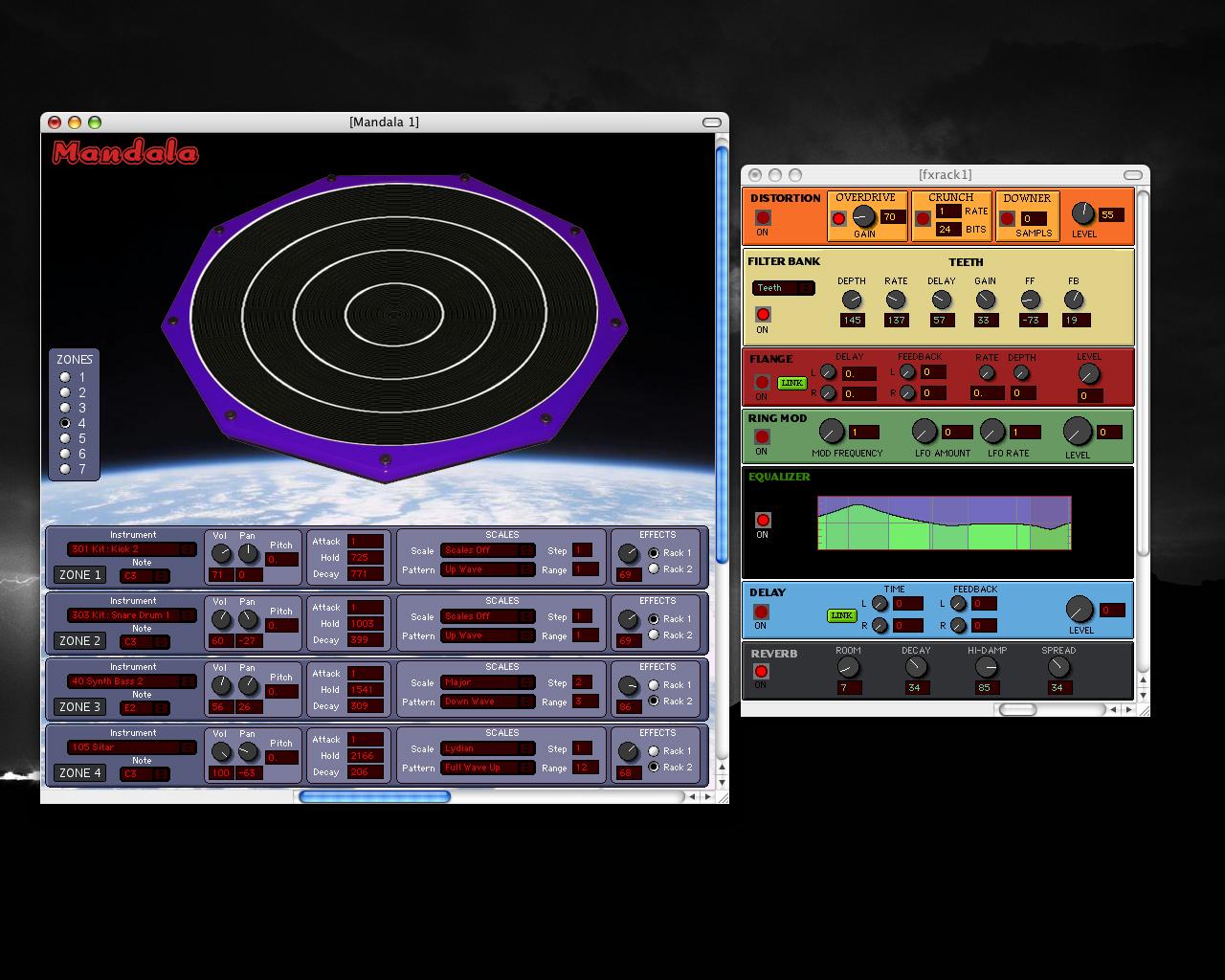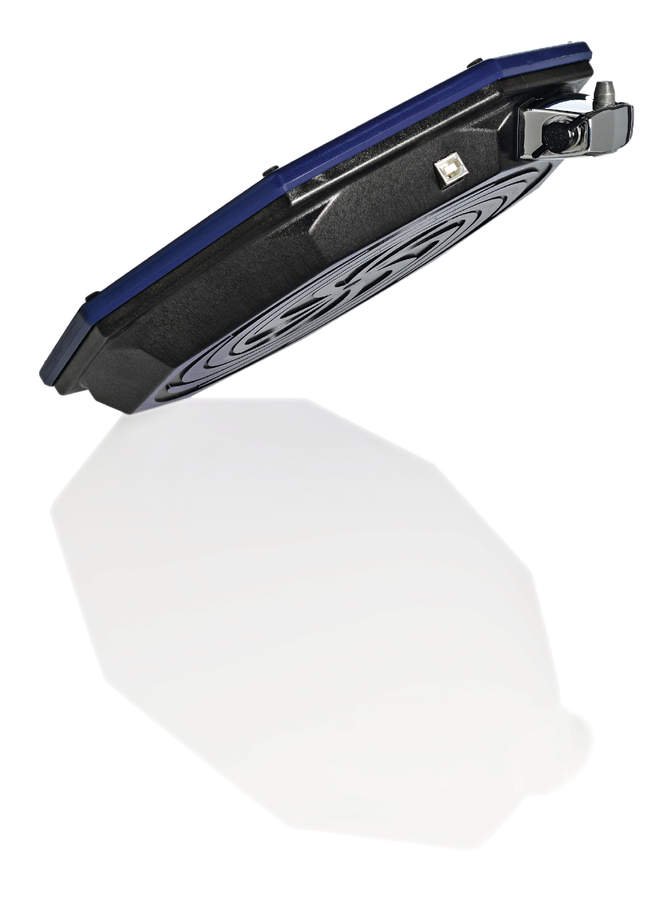MusicRadar Verdict
Pros
- +
Highly responsive playing surface. Plenty of controller options. Simple Virtual Brain interface.
Cons
- -
Knobs can be fiddly. There's a waiting list if you want one.
MusicRadar's got your back



Synesthesia Corp´s original Mandala drum pad has garnered support from some big names in the drumming world - in particular, Tool's Danny Carey, who helped in its development.
The first version had an external 'brain', but with v2.0, this been replaced with a USB connector on the drum, with the ‘brain´ being shifted into a piece of software (the Virtual Brain).
The Mandala itself is about 30cm in diameter and has a standard drum mounting bracket on its side, so you'll need the appropriate drum hardware to set it up. It feels solid, with a substantial layer of rubber forming the playing surface, which has enough bounce to not upset a drummer´s sticking mojo.
The Mandala has adjustable velocity sensitivity and can be divided into seven concentric strike zones, each of which can be assigned in a variety of ways via the Virtual Brain. It also recognises 128 concentric 'data rings', which can again be assigned to most parameters (effects, pan, pitch, etc) within the interface.
Virtual Brain
The Virtual Brain interface has been created with Cycling '74´s Max/MSP visual programming environment. As a result, it´s a standalone program and doesn´t need to be ‘installed´ - it's just a matter of dragging the contents of the supplied CD to your hard drive.
Setting up the audio interface and MIDI assignments is a doddle, with the Mandala being recognised as a native USB audio device. There´s no need to install third party drivers either - it couldn't be any simpler.
Want all the hottest music and gear news, reviews, deals, features and more, direct to your inbox? Sign up here.
The Virtual Brain loads with two main windows on display: the Pad window and the Master window. These are pretty self-explanatory: the former deals with assignments and controllers for each of the seven pad zones, and the latter covers mix controls (with output meters and individual levels for up to five Mandala pads), preset loading/saving, audio/MIDI setup and FX master levels.
The software window is dominated by a large depiction of the pad with concentric white rings (with numbers) indicating how many zones are currently being used. This feels like a waste of precious space when you consider the number of parameters that also need room on-screen.
Below the pad are the real nuts and bolts of the Mandala - the seven 'dashboards' that detail the main parameters for each of the zones. Instrument/sample selection and MIDI note assignment precedes essentials such as volume, pan position, pitch adjustment, effects send levels and the AHD envelope (Attack, Hold and Decay).
Between the envelope and effects levels is a box labelled 'Scales', which is essentially an arpeggiator (a peculiar feature for an electronic drum). By selecting a scale or mode (of which there is a full range) one can have a series of notes played by repeatedly striking the zone.
The pattern of notes, pitch range and how the pattern is stepped through can also be adjusted to suit, and it transpires that this feature can produce some pleasing results.
Taking control
The Mandala comes with over 150 sampled instruments so there´s immediately a reasonable spread of sounds to work with (from pianos and marimbas to hi-hats and tablas). You also get a separate 3GB Ludwig Black Beauty snare drum (this comes with its own player) and you can load your own samples for tweaking and triggering.
When used like this, the Mandala really starts to make sense as a live and studio tool. The only gripe we have with the interface - other than the excessive amount of space taken up by the picture - is that the knob rotation and data selection is a little fiddly and hard to adjust in small increments.
Each 'dashboard' enables you to send the zone to one of two effects racks. These have a set selection and routing of processors: distortion, delay, flange, ring modulation, equalisation, filtering and a master reverb (the only global effect).
Though not mind-blowing, these are all good sounding effects with enough parameters to enable some creative sound shaping. The fiddly data entry and knob rotation are again a little bit of a hindrance, but what we´d really like to see are some BPM-based time parameters, which can save a lot of time when matching delays or LFOs to a track.
The dashboards and the effects racks have a controller window which gives you control of all the main parameters by strike velocity, strike position (in reference to the 128 concentric data rings) and global LFO. Though this sounds like a whole load of programming hell, if one multiplies the dashboard parameters by seven, it´s actually simple, useful and really enhances the creative possibilities of the Mandala.
Just to add to the overall usefulness, the Mandala also doubles as a MIDI controller and, with a bit of scrolling down the somewhat slow preset list to Prog 250, you can change the MIDI output note/channel of each zone as well as the controller number/ channel/range for the strike position and velocity.
You can also change the MIDI output note on the dashboard to save the scrolling if that's all you need to do. The Mandala also works the other way around (ie, with the Virtual Brain being played from a MIDI sequencer).
Summary
The Mandala has been developed (at least in part) by drummers and is obviously aimed at them too, but that´s not to say it that it wouldn´t be useful in any musically creative environment. The purple paint job gives it a toy-like appearance, but it's no gimmick.
The flexibility of the Mandala is impressive, especially as it's so simple to program. The price is also very attractive, particularly for those in the UK still enjoying a buoyant exchange rate with the US.
This is a bargain for anyone who wants to expand their percussive setup without shelling out for a whole electronic kit.
MusicRadar is the number 1 website for music makers of all kinds, be they guitarists, drummers, keyboard players, djs or producers...
GEAR: We help musicians find the best gear with top-ranking gear round-ups and high- quality, authoritative reviews by a wide team of highly experienced experts.
TIPS: We also provide tuition, from bite-sized tips to advanced work-outs and guidance from recognised musicians and stars.
STARS: We talk to musicians and stars about their creative processes, and the nuts and bolts of their gear and technique. We give fans an insight into the actual craft of music making that no other music website can.
